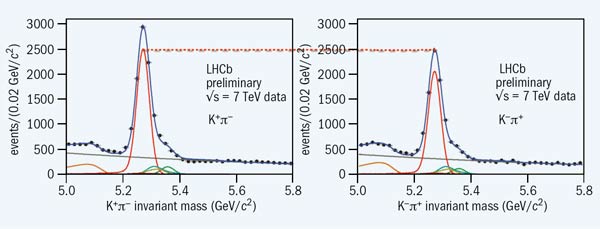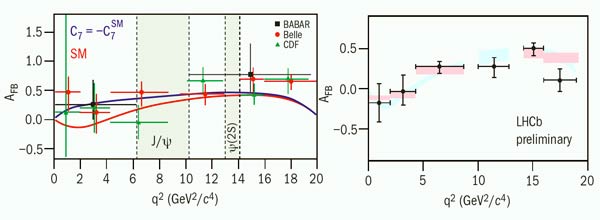EPS-HEP 2011
In this issue, news from the LHC experiments focuses on a few highlights at the first big summer conference.

The LHCb experiment has been designed to focus on B physics, which offers a rich hunting ground for new physics as the large numbers of B hadrons produced at the LHC allow the detailed study of rare processes. Two results presented at EPS-HEP 2011 show how quickly the experiment has been able to access this kind of physics. In one case, LHCb has made the first 5σ observation of a CP asymmetry at the LHC, in the mode B0→Kπ; in the other, the collaboration has made the most precise measurement to date of the forward-backward asymmetry of the rare decay B0→K*0μ+μ–, which is very sensitive to new physics.
The CP asymmetry for the B0→Kπ decay is defined as ACP(B0→Kπ) = [Γ(B0→K–π+) – Γ(B0→K+π–)] / [Γ(B0→K–π+) + Γ(B0→K+π–)]. As figure 1 shows, the asymmetry is clearly visible in the raw invariant mass distribution measured by LHCb for a data sample corresponding to 320 pb–1 of integrated luminosity – i.e. most of the data taken up to the LHC’s technical stop in June, just a month prior to the conference. However, to correct for any asymmetry in the production of the B0 and B0 and in the detection of the different final states, the collaboration uses control channels, such as B0→J/Ψ K*0 and D*+→D0π+; they also compare results taken with opposite polarities of the detector’s magnetic field. The corrections are typically at the percent level and yield a corrected asymmetry of ACP = –0.088 ± 0.011 ± 0.008.
This result is a world best, with a significance of more than 5σ, and is in good agreement with the existing world average of ACP(B0→Kπ) = –0.098 +0.012–0.011. It is an important landmark for LHCb. The many CP asymmetries in B decays can be sensitive to physics beyond the Standard Model and form an important part of the physics programme for the experiment.
In a second study, LHCb has observed the decay B0→K*0μ+μ–. This is a rare mode involving a flavour-changing neutral current; it proceeds via a b→s transition through a loop diagram, with a branching ratio of order 10–6. New physics processes can therefore enter at the same level as the Standard Model processes, making the decay a sensitive probe of contributions from new physics. The partial rate as a function of the di-muon invariant mass squared (q2) and the di-muon forward-backward asymmetry (AFB) can both be affected in many new physics scenarios. Existing measurements of AFB vs q2, which are shown on the left side of figure 2, have all tended to be rather higher than the expectation from the Standard Model, hinting at possible new physics, although the individual statistical significance is small.

LHCb has already collected over 300 events for B0→K*0μ+μ–, with a signal-to-background ratio above three. This is the largest sample of such decays in the world, and is even cleaner than the samples used by the B factories. The right side of figure 2 shows the distribution of AFB vs q2 for these events, which is in good agreement with the Standard Model expectation (shown by the shaded bands). The collaboration plans to continue to study this channel in finer detail, with measurements that include more angular variables, and expects to achieve high sensitivity to any small deviation from the Standard Model.








